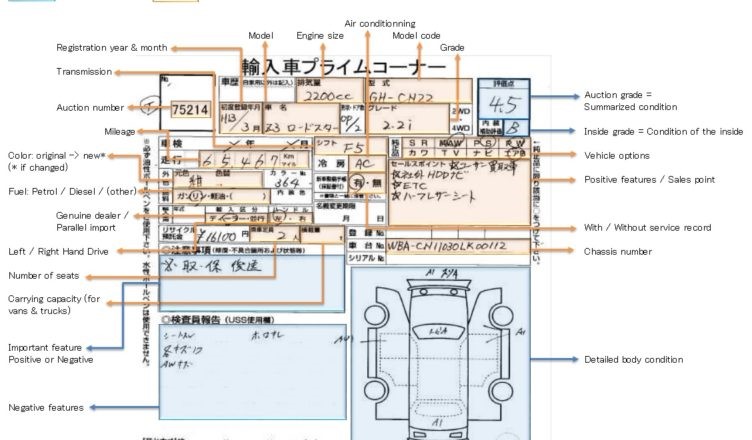
How to Read a Japanese Car Auction Sheet
What is a Japanese Car Auction Sheet?
All pre-used vehicles in Japan undergo an extensive inspection before a car auction begins. The rating for the vehicles is displayed on a Japanese car auction sheet, which is prepared by professional inspectors hired by auction houses.
The car auction sheet is completed after a full mechanical inspection. During the testing phase, the interior and exterior parts of the vehicle are graded based on a set of standards. Aside from the grades of the vehicle, the Japanese car auction sheet also displays the inspector’s explanation for the grades awarded to the vehicle, along with a grade for its overall condition.

What’s in a Car Auction Sheet?
The car auction sheet provides basic information on the vehicle, including the following:
- Production Month and Year: The actual production month and year of the vehicle is displayed on the car auction sheet to help prospect buyers calculate its exact age.
- Lot Number: Japan houses the largest selection of used car models and makes. The used cars are grouped into different lots. A lot number enables you to clearly identify and locate a vehicle. Also, it is helpful in validating the car auction report.
- Body Type: If the vehicle was built with 4 doors, “4D” is written on this section.
- Engine Displacement: The car auction sheet provides data on the engine size of the vehicle.
- Car Type: As the name implies, this segment provides data on the vehicle type.
- Interior and Exterior Parts: As mentioned above, the inspector grades the interior and exterior parts of the vehicle to give prospect buyers an idea on its overall quality. The exterior rating of the vehicle is displayed on the left, while the interior rating is written on the right section of the box. A is the highest grade awarded for both exterior and interior parts.
- Chassis Code: All cars manufactured in Japan have their own chassis code.
- Chassis Number: Used for authenticating and verifying a purchase, the chassis number helps you check if the vehicle you purchased online is the same vehicle shipped to your country.
- Auction Grade: The auction grade is the overall rating of the condition of the vehicle. “S” means brand new, “R” is for repaired and “XX” stands for damaged car. Also, the car is graded by numeric figures. As a rule of thumb, the lower the figure is, the lower the quality of the vehicle is. Below is a guide on the grading system:
- Grade 6: Brand new
- Grade 5: As good as new
- Grade 4.5: Very slightly used
- Grade 4: Used with the slightest blemishes
- Grade 3.5: Good condition with visible blemishes
- Grade 3: Average condition with light damage
- Grade 2: Poor condition
- Grade R or RA: Repaired or heavily modified vehicles
- Comments: This is the part where the inspector/seller writes down comments about the vehicle. The comments are written in Japanese characters, but you can use Google translate or any language-translating app so you can understand the comments in this section.
- Additional Features: This section displays the air conditioning system and the transmission type of the vehicle. For instance, “FAT” stands for Floor-Shift Automatic Transmission, while “AAC” means Automatic Air Condition or climate control.
- Additional Accessories: In this section, initials are used to express any additional features of the vehicle. For example, “PW” stands for power windows while “PS” means power steering.
- Mileage Diagram: The car’s diagram provides you a clear overview on the overall condition of the car. It includes any dents, scratches of flaws on the body of the vehicle. The flaws are represented by alphabetic characters that translate to defects and of differing severity. Below is a translation of each character:
| Characters | Defects | Comments |
|---|---|---|
| A1 | Small scratch | |
| A2 | Scratch | |
| A3 | Big scratch | |
| B | Dent with scratch | |
| E1 | Few Dimples | |
| E2 | Several Dimples | |
| E3 | Many Dimples | |
| U1 | Small dent | |
| U2 | Dent | |
| U3 | Big dent | |
| W1 | Hardly detectable repair mark/wave | |
| W2 | Repair mark/wave | |
| W3 | Visible repair mark/wave | |
| S1 | Rust | |
| S2 | Heavy Rust | |
| X | Must be replaced | |
| XX | Replaced | |
| B1 | Distorted radiator back panel or core support | |
| B2 | Highly distorted radiator back panel or core support | |
| Y1 | Small crack or hole | |
| Y2 | Crack or hole | |
| Y3 | Big crack or hole | |
| X1 | Small windshield crack | |
| R | Repaired windshield crack | |
| RX | Repaired windshield crack (must be replaced) | |
| X | Windshield crack (must be replaced) | |
| G | Stone chip in glass | |
| C1 | Corrosion | |
| C2 | Heavy corrosion | |
| P | Marked paint | |
| H | Faded paint |
By reviewing the car auction sheet, you can make informed decisions as you import a used car from Japan. If you need more assurance, you can ask the auction house to perform more extensive car inspections before you purchase the vehicle.